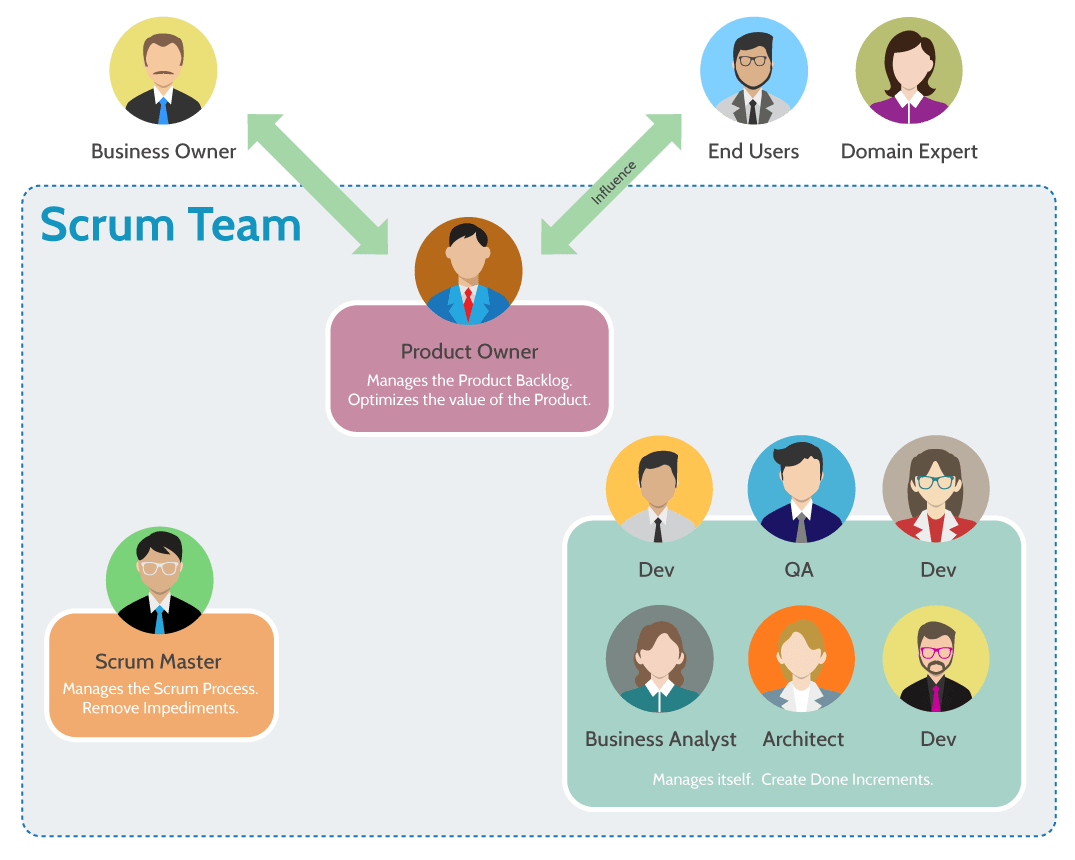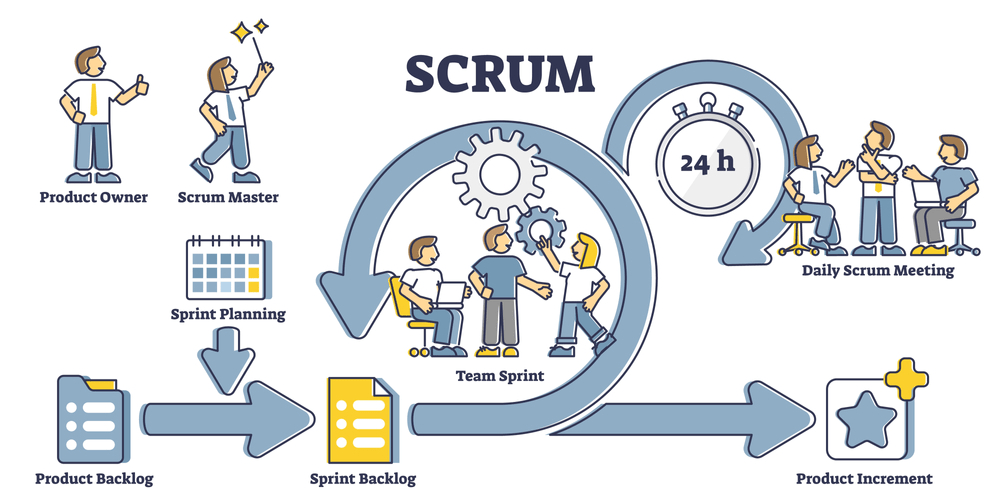
- Introduction
- What is Scrum?
- The Scrum Team Structure
- Scrum Roles: An Overview
- Responsibilities of Each Scrum Role
- Collaboration and Communication in Scrum Teams
- Best Practices for a Scrum Team
- Conclusion
Eager to Acquire Your Data Science Certification? View The Data Science Course Offered By ACTE Right Now!
Introduction
Scrum is one of the most widely adopted Agile frameworks, particularly popular in software development, but its principles extend to various industries. At its core, Scrum emphasizes collaboration, adaptability, and incremental progress through sprint cycles. The success of any Scrum project hinges on how effectively the Scrum team collaborates and executes its roles. Each team member brings a unique set of responsibilities to the table, all contributing to the project’s overall success. A Scrum team has three primary roles: the Product Owner, the Scrum Master, and the Development Team. The Product Owner is responsible for defining the product backlog, prioritizing features, and ensuring the team works on the most valuable tasks, such as those related to high-impact initiatives like Data Science Training. The Scrum Master is a facilitator, helping the team follow Scrum practices, removing obstacles, and ensuring that the team remains focused and productive. The cross-functional development team works collaboratively to deliver product increments during each Sprint. To achieve the best outcomes, Scrum teams must embrace certain best practices, such as clear communication, regular feedback loops, and continuous improvement. By focusing on collaboration and maintaining flexibility throughout the process, Scrum teams can consistently deliver high-quality results efficiently and effectively.
What is Scrum?
Scrum is an Agile framework that promotes teamwork, accountability, and continuous improvement. It divides the project into small, manageable units called sprints (usually 2-4 weeks long). The idea is to deliver minor, incremental improvements to the product, allowing stakeholders to see progress regularly and adjust the development course as needed. Scrum is based on three pillars: Transparency, inspection, and adaptation. The Scrum Team is central to the success of this framework, and understanding their roles and responsibilities is key.

The Scrum Team Structure
- The Scrum team comprises three core roles: the Product Owner, the Scrum Master, and the Development Team, each with distinct responsibilities that contribute to the team’s success within the Scrum framework.
- The Product Owner is responsible for defining and prioritizing the product backlog, ensuring the team works on the most valuable features. They act as the voice of the customer and stakeholders, providing clarity on requirements and making decisions about what to build.
- The Scrum Master facilitates the Scrum process, ensuring the team follows Scrum practices. They help remove obstacles that may impede progress, protect the team from external disruptions, and guide it in continuous improvement.
- The Development Team consists of cross-functional members who work collaboratively to deliver the product increment. They are responsible for designing, building, and testing the product within each Sprint, ensuring the delivery of a high-quality product increment.
- Together, these roles ensure effective teamwork, Transparency, and iterative progress within the Scrum framework.
- Prioritizing the Product Backlog.
- Ensuring that the team understands the items on the backlog.
- Engaging with stakeholders to gather feedback.
- Coaching the team on Scrum practices.
- Facilitating Scrum events (like Daily Standups and Sprint Planning).
- Removing any blockers or impediments the team faces.
- Completing the tasks in the Sprint Backlog.
- Self-organizing to decide how best to accomplish their work.
- Ensuring high-quality product increments are delivered at the end of each Sprint.
- Daily Standups: This is a short meeting where team members share what they did yesterday, what they will do today, and if there are any impediments. It’s a key tool for aligning the team and ensuring issues are spotted early.
- Sprint Reviews: At the end of each Sprint, the team demonstrates the work completed to Impact of the Stakeholders . This fosters collaboration and ensures alignment between the team and stakeholders.
- Sprint Retrospectives: The team reflects on their performance during the Sprint and identifies areas for improvement. This meeting is essential for fostering continuous improvement.
Scrum Roles: An Overview
Product Owner
The Product Owner is responsible for defining the vision and ensuring the team works on the highest-priority items to deliver the most Value to the stakeholders. They own the Product Backlog, the list of features, enhancements, and bug fixes that need to be worked on.
Key responsibilities:
Excited to Obtaining Your Data Science Certificate? View The Data Science Training Offered By ACTE Right Now!
Scrum Master
The Scrum Master serves as a facilitator for the Scrum team. They ensure that Scrum practices are followed, remove obstacles that may hinder the team, and act as a bridge between the team and the rest of the organization. They’re also there to coach the team on becoming more efficient.
Key responsibilities:
Development Team
The Development Team is a group of professionals who collaborate to deliver a potentially shippable product increment at the end of each Sprint. This cross-functional team, essential to effective Scrum Project Management, possesses all the necessary skills to design, develop, test, and provide the product.
Key responsibilities:
Interested in Pursuing Data Science Master’s Program? Enroll For Data Science Master Course Today!
Responsibilities of Each Scrum Role
Understanding the responsibilities of each Scrum role is critical for the smooth operation of the Scrum Team. The Product Owner is responsible for defining the product vision and ensuring the team consistently works toward it. They manage and prioritize the Product Backlog to focus the team’s efforts on the most valuable work. Additionally, they engage with stakeholders to ensure the product meets business needs and expectations and define clear acceptance criteria for backlog items to guide development efforts. The Scrum Master facilitates all Scrum events, such as Daily Standups, Sprint Planning, Sprint Reviews, and Retrospectives, ensuring each serves its intended purpose. They are also responsible for identifying and removing any impediments that could hinder the team’s progress. Furthermore, the Scrum Master acts as a coach, helping the team understand and apply Scrum principles, while fostering a culture of continuous improvement through initiatives such as Data science Training. The Development Team is tasked with delivering a high-quality product increment at the end of each Sprint. This self-organizing team determines how best to accomplish its work, encouraging autonomy and accountability. The team collaborates closely, utilizing its members’ diverse skill sets to solve problems and deliver value. It also embraces continuous improvement, reflecting on each Sprint to refine its processes, practices, and team dynamics.

Collaboration and Communication in Scrum Teams
A core aspect of Scrum is effective collaboration and communication. Since Scrum is built around iterative and incremental progress, continuous feedback and adjustments are necessary.
Preparing for a Data Science Job Interview? Check Out Our Blog on Data Science Interview Questions & Answer
Best Practices for a Scrum Team
Scrum teams can maximize their effectiveness by following several key best practices. First, transparency is essential every team member should have equal access to information and openly share their progress and challenges. Tools like Jira or Trello can help maintain visibility into the backlog and ongoing Sprint work. Second, teams must focus on delivering value, with the Product Owner ensuring that the team understands the purpose behind each task. This clarity keeps the team motivated and outcome-driven. Third, adaptation and continuous improvement reinforced through regular Scrum Ceremonies are at the heart of Scrum. Teams should regularly reflect during Retrospectives and make necessary adjustments based on performance and stakeholder feedback to keep the product aligned with business goals. Finally, the effective use of Scrum events such as Sprint Planning, Daily Standups, Sprint Reviews, and Retrospectives is vital. These meetings promote communication, alignment, and improvement, and the Scrum Master plays a key role in ensuring they are purposeful and productive.
Conclusion
Scrum teams are dynamic and collaborative units designed to deliver high-quality products iteratively and incrementally. Each team member plays a vital role in ensuring the project’s success. The Product Owner is responsible for maintaining the product backlog, prioritizing features based on Value, and ensuring the team works on the most critical tasks. They represent the voice of the customer and stakeholders, guiding the direction of the product. The Scrum Master is a facilitator, ensuring the team follows Scrum practices and helping to remove any obstacles hindering progress, including those that may arise during initiatives like Data Science Training. They create an environment where the team can focus, collaborate, and continuously improve their processes. The Development Team, a cross-functional group of professionals, works together to design, build, and test the product increment in each Sprint. They are self-organizing and responsible for delivering high-quality work within the agreed-upon timeframe. By embracing Transparency, focusing on providing Value, and fostering a culture of continuous improvement, Scrum teams can overcome challenges and consistently achieve successful outcomes.


